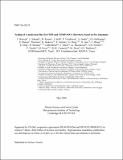| dc.description.abstract | This contribution aims to improve existing scalings of the L-mode power decay length Lambda_q_OMP, especially for plasma configurations with strike points at the ITER-relevant location—closed vertical divertor targets. We propose 13 new Lambda_q_OMP scalings based on data from the tokamaks JET, EAST, MAST, Alcator C-mod and COMPASS, and validate them against the output of the 2D turbulence code HESEL. The analysis covers 500 divertor heat flux profiles (obtained by probes or IR cameras), measured in L-mode discharges with varying 12 global plasma parameters (all well predictable). We find that the two previously published scalings (Eich 2013 J. Nucl. Mat. 438 S72) and (Scarabosio 2013 J. Nucl. Mat. 438 S426), which were based on outer target data from AUG and JET, describe the JET, C-mod and COMPASS profiles well. This holds not only at the outer horizontal and vertical targets, but surprisingly also at the inner vertical targets. In contrast, EAST, HESEL and especially MAST data are poorly described by these two scalings. We therefore derive 13 new scalings, which account for 85–92 % of the measured Lambda_q_OMP variability across all five tokamaks. Although each of the scalings is based on a different parameter combination, their predictions for the ITER and COMPASS-Upgrade tokamaks are very similar. Just before the L-H transition in the ITER baseline scenario, the presented scalings predict values Lambda_q_OMP = 3.0 +/-0.5 mm. For the COMPASS-Upgrade tokamak, all the scalings predict Lambda_q_OMP = 2.1 +/- 0.5 mm with a single exception of the scaling based on the stored plasma energy which predicts only 1.2 mm for both tokamaks. We encourage the reader to use as many of these scalings as possible, depending on available data. In attached plasma and using significant assumptions, our results imply steady-state surface-perpendicular heat flux around 10 MW/m^2 for ITER, and 20 MW/m^2 for COMPASS-Upgrade. | |
